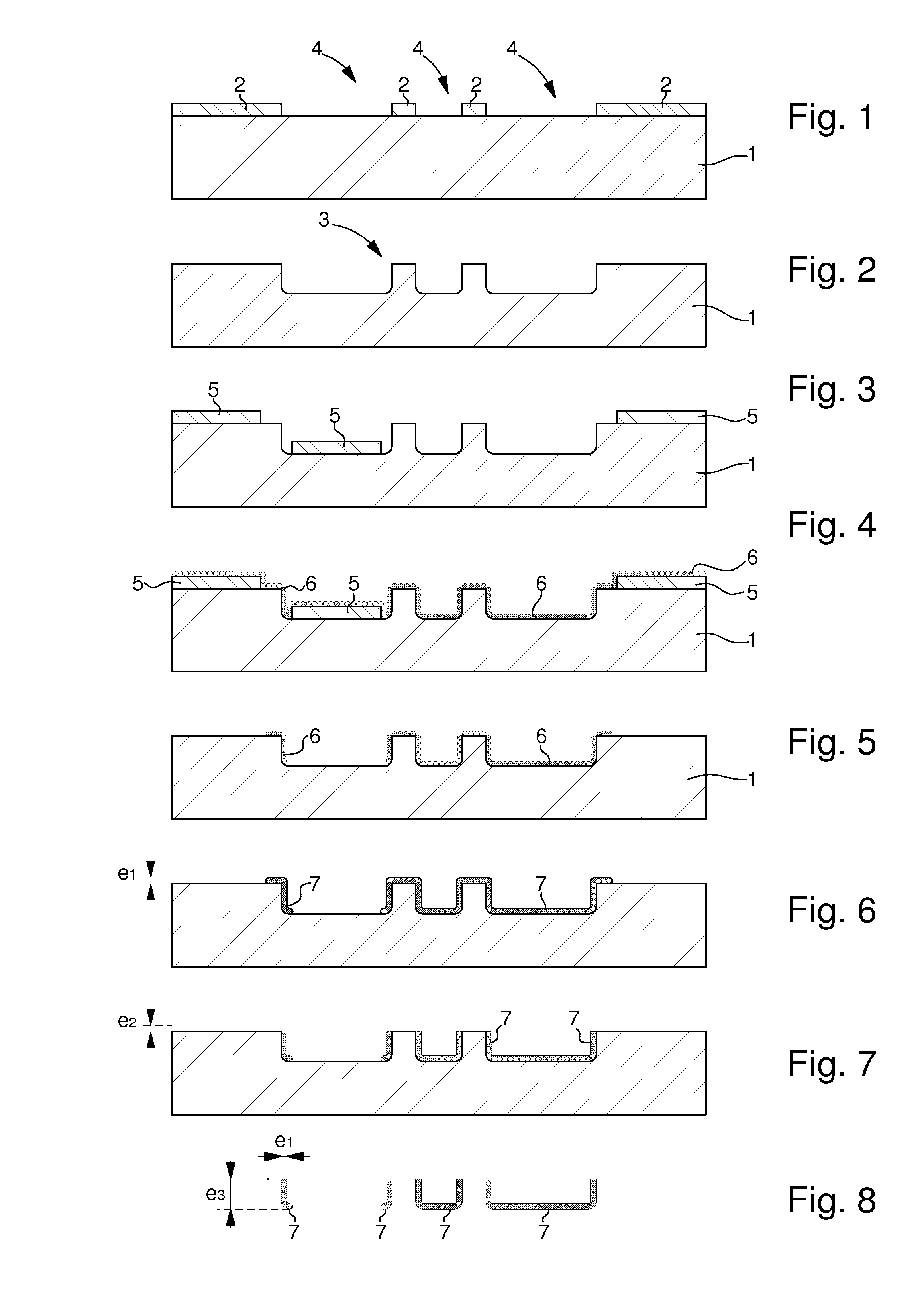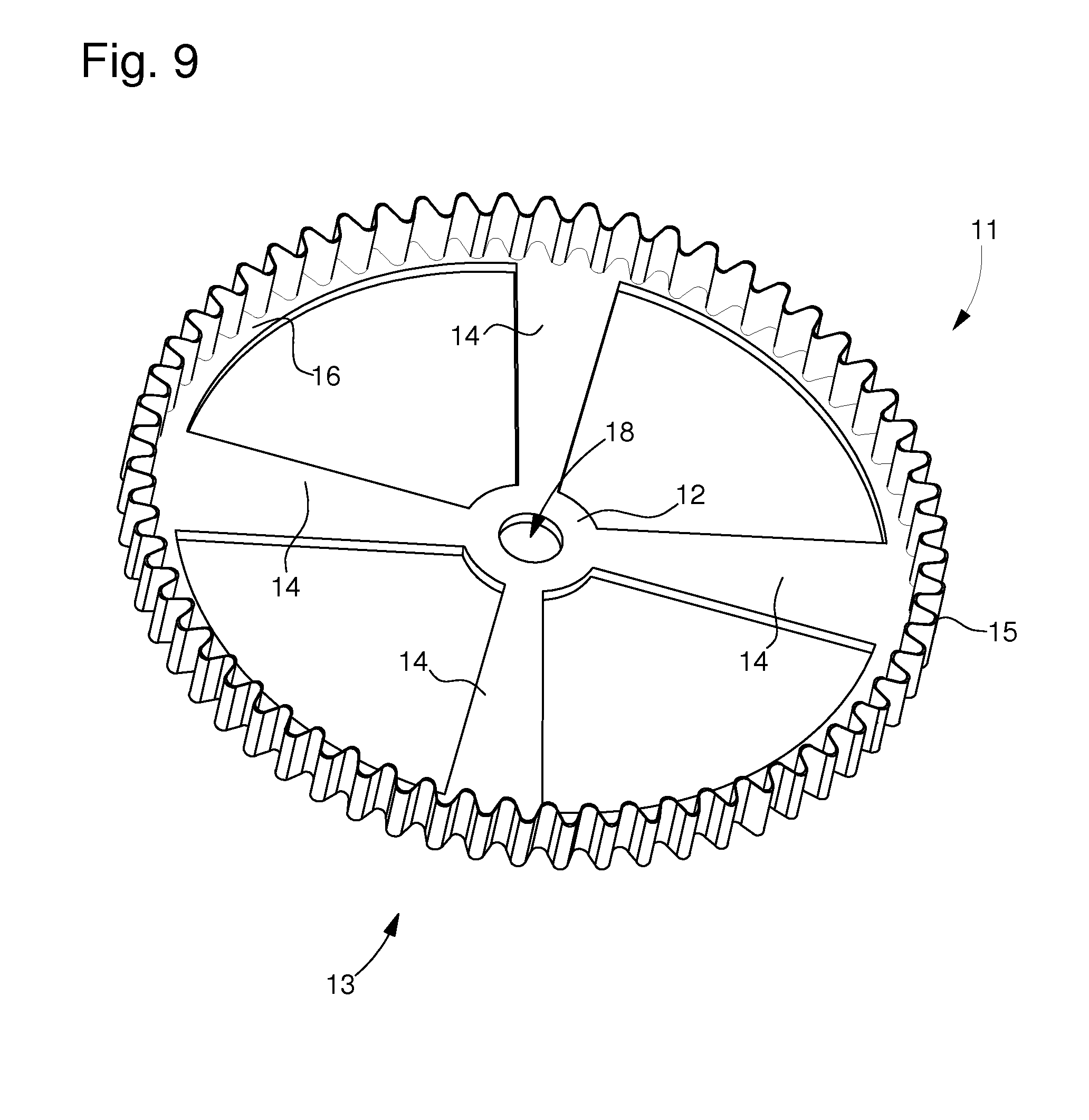Complex pierced micromechanical part
a micro-mechanical part and complex technology, applied in the field of complex micro-mechanical parts, can solve the problems of high cost and inconvenient tribologically, and achieve the effects of favourable scrap rate and production cost, improved roughness and improved tribological properties
- Summary
- Abstract
- Description
- Claims
- Application Information
AI Technical Summary
Benefits of technology
Problems solved by technology
Method used
Image
Examples
first embodiment
[0034]the method of fabricating this micromechanical part is presented in FIGS. 1 to 8. In step a), the method consists in forming, in a substrate 1, a negative cavity 3 for the future micromechanical part. A large variety of substrates 1 is possible. Preferably, the material of substrate 1 is selected for its low roughness, i.e. the natural feature of having a smooth surface, but also for its resistance to the aggressiveness of the deposition steps.
[0035]By way of example, FIGS. 1 and 2 show step a formed from a silicon substrate 1 for which it is possible to obtain very good roughness, i.e. an arithmetic mean value Ra of substantially less than 10 nm.
[0036]Thus, in a first phase illustrated in FIG. 1, substrate 1 is coated with a mask 2 having holes 4 which leave a top portion of substrate 1 exposed. In a second phase, etching is performed in holes 4. This etching may be wet or dry etching. Finally, in a third phase illustrated in FIG. 2, the mask 2 is removed, leaving only the ne...
second embodiment
[0055]In a fifth step e of the second embodiment, the method consists in depositing a material 27 by chemical vapour phase deposition so that particles 26 are exclusively deposited or remain. At the end of step e), as illustrated in FIG. 13, there is obtained a substrate 21, directly formed with the desired partial layer of material 27.
[0056]The method according to the second embodiment of the invention may also include an optional sixth step g, which is identical to that of the first embodiment, but has not been illustrated.
[0057]In a last step f of the second embodiment, the method consists in removing substrate 21, so as to release the micromechanical part formed in cavity 23, with the same variants and advantages as in the first embodiment.
[0058]At the end of step f, as illustrated in FIG. 14, there is obtained a micromechanical part, formed exclusively by layer 27, the geometry of which at least partially matches cavity 23. Advantageously, when optional step g is not performed,...
third embodiment
[0068]Consequently, in this third embodiment, optional step g) may be used to limit the thickness of said layer 7, 27 in said negative cavity 3, 23, but also to make deposition 8 of the second material flat relative to said limited portion.
[0069]It is also clear that it is possible to obtain a micromechanical part with the same complexities as in the first two embodiments. By way of non-limiting example, a micromechanical part 31, which can be obtained according to the first embodiment, is shown in FIG. 18. Micromechanical part 31 includes a substantially annular plate 33 from the periphery of which a toothing 35 projects orthogonally, the rest being filled by portion 32 formed by the step h deposition 8, leaving a hole 38 for cooperation, for example, with a pivot pin. The thickness of toothing 35 is thus formed by the thickness e1 of layer 7, 27 deposited in step e of the method and deposition 8 obtained in step h.
[0070]A fourth alternative embodiment to the first and second embod...
PUM
| Property | Measurement | Unit |
|---|---|---|
| roughness | aaaaa | aaaaa |
| thickness e1 | aaaaa | aaaaa |
| thickness e1 | aaaaa | aaaaa |
Abstract
Description
Claims
Application Information
 Login to View More
Login to View More - R&D
- Intellectual Property
- Life Sciences
- Materials
- Tech Scout
- Unparalleled Data Quality
- Higher Quality Content
- 60% Fewer Hallucinations
Browse by: Latest US Patents, China's latest patents, Technical Efficacy Thesaurus, Application Domain, Technology Topic, Popular Technical Reports.
© 2025 PatSnap. All rights reserved.Legal|Privacy policy|Modern Slavery Act Transparency Statement|Sitemap|About US| Contact US: help@patsnap.com



